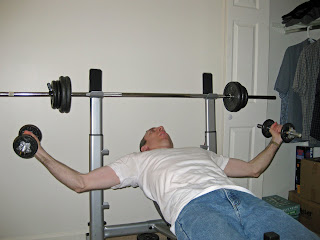Let's be clear: I don't have a 6-pack. At least not one that is visible. I certainly have a flat abdomen but its musculature is not well defined. Of course everyone has a 6-pack, but abdominal muscles are often obscured by a layer of fat. As skinny as people think I am, I still have a layer of fat there. After all, it is rare to see a 35-year old with a six pack. Using skin-fold calipers I can tell you exactly how thick my fat layer is. I measure a skin fold near my belly button to be 14.3 mm, but that represents a skin-and-fat layer folded upon itself, so really the layer of skin and fat is half that--7.2 mm. That seems pretty thin, so I'm surprised that my 6-pack isn't showing through. But not yet. So what should I do if I want better-defined abs? The answer is lose the fat. There is no other answer. I do not need to exercise my abdominals more, because no matter how developed they are, if they are still lying underneath a layer of fat, they will not be revealed. Scooby Werkstatt posted a good piece on this.
Sometimes I wonder if I am obsessing over my newly discovered body. If I am, please allow me to do so for a little while longer. I am not endangering myself through starvation or over-training.
So, speaking of training, this entry is about abdominal muscles and I might as well talk about the crunches I do, because I am interested in developing those muscles, even if my efforts won't show when I go without a shirt.
For a time I also rotated my body from side to side as I did my crunches. This was supposed to work my obliques in addition to my abdominus rectus muscles. This felt awkward so I stopped doing it.
Once I could do one set of 45 crunches, I still felt I needed more of a challenge, so I added Incline Leg Raises. In this exercise I used a 20-degree vertical incline on the weight bench with my legs straight out in front of me. Then I raise both legs over my head to touch the wall behind me. I do bend my knees slightly to remove strain as I elevate the legs. This exercise is described on page 138 of Delavier (2006) and there he states: "This is an excellent exercise if you have trouble feeling work on the lower abdominal muscles." Yes, that's me. I don't want the lower muscles to miss out on getting exercise!







